|
|
 |
Business I. Electrospray Deposition (ESD) technology
|
The Electrospray Deposition technology (ESD method) is the technique of spraying various kinds of solution and suspensions of various polymers, to make them form nano-sized particles and fibers (nanofiber), and to let them deposit or adhere on a substrate using electrostatic force.
While electrospray is a very complicated physical process which is not fully understood, generally what happens is as follows. When a sample liquid stored in a thin capillary is supplied with from thousands to tens of thousands voltage, a strong electric field is generated at the tip of the capillary, due to the effect of electric field concentration. As the liquid begins to exit from the capillary, it forms a conical shape with the electrically charged ions gathered on its surface.
Subsequently, when the electrostatic force becomes stronger than surface tension, the liquid splashes from the tip of the capillary to form a fine jet. Since the jet is highly charged, the liquid immediately turns into fine droplets to generate spray with each droplet spilt from the next by electrostatic force.
The droplets formed by means of electrospray are tiny. Therefore, the solvent evaporates and dries in a very short period of time, and as a consequence, it forms nanofiber or very fine nano-particles. These charged nanofiber or tiny particles are attracted to the counter-electrode by electrostatic force, and are deposited in various patterns, which can be controlled by mask(s) made of insulating material and/or additional electrode(s).
|
 |
Electrospray Deposition |
 |
Example of structure |
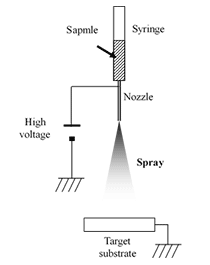 |
|
nanofiber
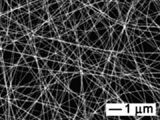
|
Nano particle
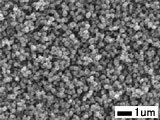
| |
nano-coating
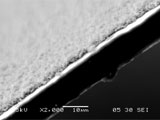
|
micro-patterning

|
|
|
 |
| 1.Features |
 |
The Electrospray Deposition Method can:
- 1. spray various substances, including solution and suspension from organic/ inorganic compounds, bio-macromolecules and synthetic polymers ,and deposit various nano structures.
- 2. maintain the sample relatively free from damage, since the whole procedure is conducted under a room temperature and atmospheric pressure.
- 3. create nano-sized particles and fibers.
- 4. control depositions and patterns of the particle using electrostatic force.
- 5. form the nano structures in a larger area.
- 6. Since this is dry deposition, there will not be any problem which occurs as wet deposition. Of course, wet deposition can be also possible by ESD method just by changing the spray conditions.
|
 |
| 2.Applications |
 |
| (1)Nanofiber |
 |
ESD method is applicable to polymers, which is soluble in water or organic solvents.
The nanofibers fabricated by the ESD method are already commercialized as a high performance filter. It can be used as catalytic carriers as well as high-performance membranes. They are not limited to high-performance filters and non-woven fabrics. A wide variety of products are being developed, not only for textile fabrics but also for electronic parts and high-performance batteries as well as for the materials used for biological research and medical treatments.
|
 |
Polyacrylonitrile (PAN) nanofiber |
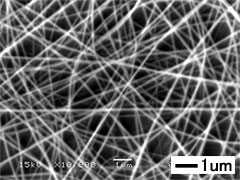 |
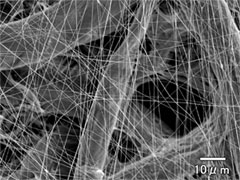 |
average fiber diameter : 128 nm, CV : 12.8% |
nanofiber coating to the filter surface |
|
 |
| (2)Thin film |
 |
|
Nanofiber and micro/nano particles are used for various thin films, and its applications and demands are getting much broader and stronger. In addition, higher performance and lower costs are requested.
|
 |
 |
 |
| (3)Nano-coating |
 |
|
The particles of materials fabricated by the ESD method can be reduced to less than tens nano-meters. Using this technique, various types of coating are practicable, with the materials like synthetic polymers and bio-macromolecules such as proteins. Thickness of the coating is controllable at the level of nano-meters, and with the electrostatic force, it is theoretically possible to coat the substrate both of flat surface and of complex shapes.
|
 |
The section and surface coarseness of organic thin film coating |
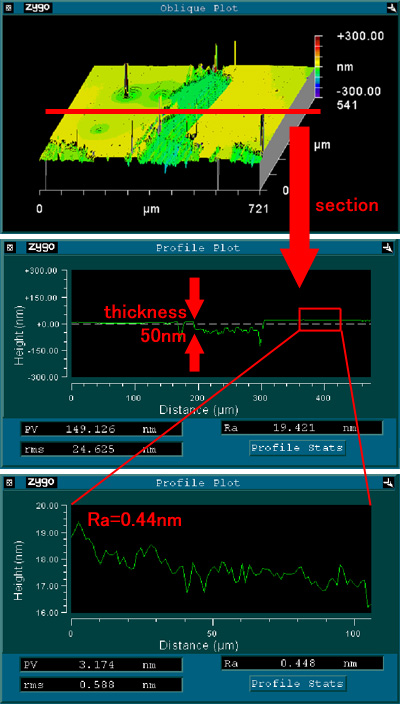
|
 |
 |
| (4)Micro-Patterning |
 |
By using a mask of insulating material in the ESD method, electrostatic force controls the pattern of deposition and forms in desired shape, either spotted or striped. The resolution of pattern is possible to several micrometers depending on conditions.
According to the nature of the substrate and the purpose of application, it carries out not only by using a mask but also by not using a mask. Deposition of various element materials and parts of electronics products, and the protein to a micro fluid chip, fixation in various form of biodegradable polymer, etc. can be performed using this patterning technology.
|
 |
Micro patterning |
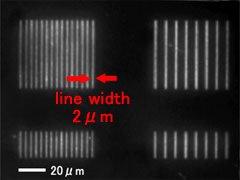
 |
 |
 |
 |
| 3.Product |
 |
| Polyimide nanofiber |
 |
|
 |
Major Characteristics
Now, as different kinds of solvent-soluble polyimides are available, a better one is used depending on an application.
|
 |
-
● Solvent soluble and commercial production
- 1. This polyimide is soluble in solvents and can make nanofiber form, and it can be
- 2. produced in large-scale.
-
● Resistant to higher temperature
This nanofiber can maintain the original high temperature-resistance and is stable at higher temperature.
-
● High thermal and electric insulation performances
The thermal conductivity is one-order lower than the film-form, and the original low electrical conductance is kept.
-
● Water-proof and breathable
Being different from film-form PI, it can be used as water-proof and breathable material.
-
● Flexible and thin membrane
The mechanical strength is kept.
|
 |
| ▲BACK TO TOP |
 |
Copyright © 2020 Fuence co.,Ltd. All Rights Reseved. |
|
|